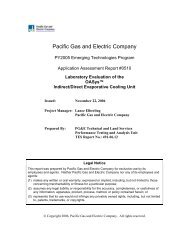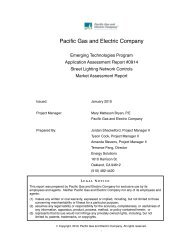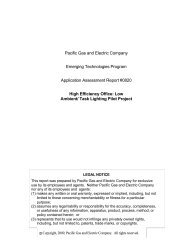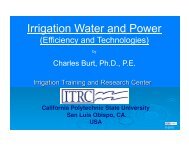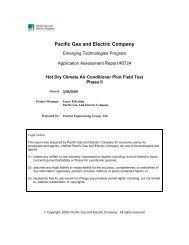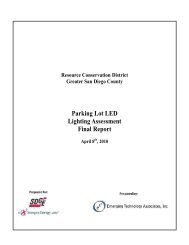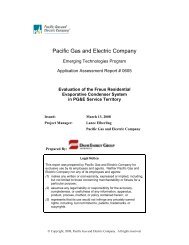PGE Water Heater ET Final Report - FINAL.pdf - Emerging ...
PGE Water Heater ET Final Report - FINAL.pdf - Emerging ...
PGE Water Heater ET Final Report - FINAL.pdf - Emerging ...
Create successful ePaper yourself
Turn your PDF publications into a flip-book with our unique Google optimized e-Paper software.
PG&E’s <strong>Emerging</strong> Technologies Program <strong>ET</strong>12<strong>PGE</strong>3191<br />
required a manufacturer to submit certifications for the same qualifying model to multiple<br />
AQMDs.<br />
Currently, the state AQMDs follow Rule 1121 promulgated by the South Coast Air Quality<br />
Management District. Rule 1121 applies to the control of Nitrogen Oxides from residentialtype,<br />
natural gas-fired water heaters:<br />
no person shall manufacture for sale, distribute, sell, offer for sale, or install within<br />
the Air Quality Management District any gas-fired water heaters unless the water<br />
heater is certified pursuant to subdivision (d) to a NOx emission level of less than or<br />
equal to:<br />
a. 10 nanograms of NOx (calculated as NO2) per joule of heat output (23 lb. per billion<br />
Btu of heat output); or<br />
b. 15 ppmv at 3% O2, dry (17.5 lb. per billion Btu of heat input).<br />
Manufacturers are also prohibited from selling or installing any water heater subject to rules<br />
unless the water heater manufacturer brand name and model is certified to Air Pollution<br />
Control Officer. This certification is current for 3 years, after which recertification must be<br />
sought. Certifications can be used across AQMDs, in some cases. In the Bay Area Air<br />
Quality Management District, these rules were effective on January 1, 2011 for all<br />
residential water heaters with an input rating of 75,000 btu/hr or less.<br />
ENERGY STAR Qualifications<br />
Qualifying water heater specifications for the ENERGY STAR program are closely coordinated<br />
with the CEC’s title 24 requirements and DOE’s water heater federal standards. ENERGY<br />
STAR specifications are voluntary and their current energy efficiency criteria are more<br />
stringent than existing and planned mandatory standards set by California and the federal<br />
government. In addition to Energy Factor (EF), ENERGY STAR water heaters must meet<br />
First-Hour Rating, Warranty, and Safety criteria.<br />
EF is the most important measure in a utility’s energy efficiency program. Currently,<br />
ENERGY STAR’s EF for natural gas storage water heaters is ≥0.67 and the EF for electric<br />
storage water heaters is ≥2.0, which only heat pump water heaters can satisfy. Whole<br />
house tankless water heaters with an EF ≥0.82 also qualify for ENERGY STAR. A list of<br />
current and historical ENERGY STAR specifications appears in Table 21 in the Appendix.<br />
Manufacturers generally prefer voluntary efficiency standards like ENERGY STAR over<br />
mandatory programs as voluntary programs are believed to be the best mechanism to<br />
promote innovation in efficient product design. 11 Though stringent criteria can be a<br />
deterrent for some manufacturers and retailers, this does not completely explain the lack of<br />
sales of ENERGY STAR water heaters in California. An additional significant barrier to<br />
uptake of ENERGY STAR-compliant water heater models is the inherent tradeoff<br />
manufacturers make in designing water heater models which adhere to the AQMD<br />
regulations, Title 24 codes, and ENERGY STAR guidance. It is technologically possible for<br />
models to be both compliant with state and regional air quality regulations while also<br />
11 Consumer Electronics Association (CEA) Energy Efficiency & Environmental Policy,<br />
http://cea.aristotle.com/pages/energy.aspx?SID=7&AuthToken=null&participantguid=null&in<br />
d_guid=null.<br />
12



